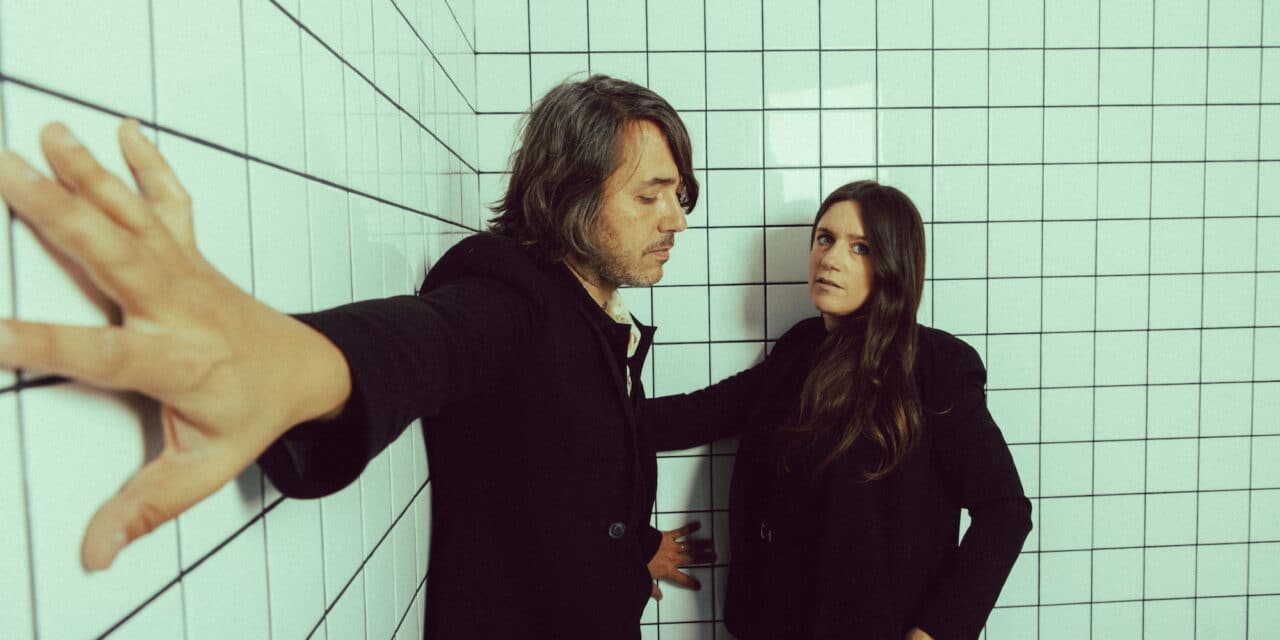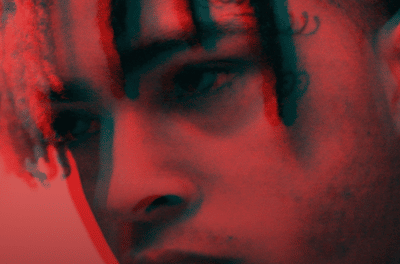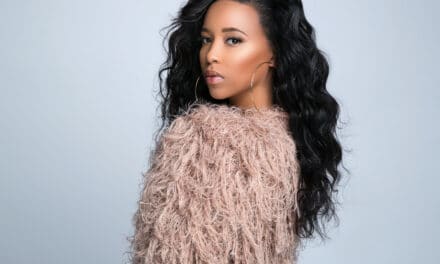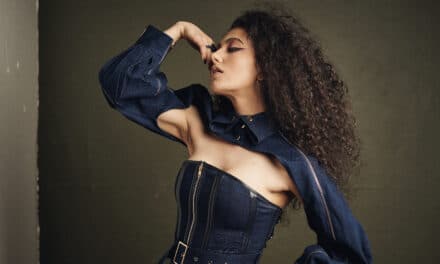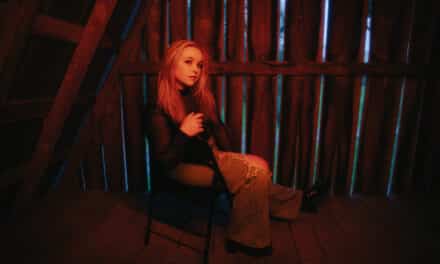Featuring chilling synths, psychedelic beats, and hypnotic vocals, “Best Friend” is a moody dance track about a toxic friendship. The accompanying video features paper mâché versions of the group’s members Marie Seyrat and Bruce Driscoll kidnapping the real versions of themselves. Inspired by setting old poems like Poe’s “The Raven” to music, Freedom Fry’s new album Best Friend is an exploration of timeless themes through a darker lens, offering a slightly different vibe than what they’ve become known for. The forthcoming 8-track collection also includes their recently released single “A Farewell” that is featured in Apple Music’s New In Alternative playlist.
Based in Los Angeles, Freedom Fry is comprised of the married duo of the Paris-born Seyrat and US-born Driscoll. Since the release of their 2018 debut album Classic, Freedom Fry has created their own musical universe – writing, producing, and recording their vastly growing catalogue ranging from emotional folk ballads to pop bangers. Freedom Fry songs have been remixed by the likes of Sofi Tukker and Penguin Prison and championed by KEXP, WXPN, the BBC, SiriusXM’s Alt Nation, Howard Stern himself, Billboard, Clash, Flaunt Magazine, NYLON, Vice, and more. Their 2021 single “Le Point Zéro” was featured in the film M3GAN and they also wrote the title track “Animals” for BAFTA award-winning TV show Lovely Little Farm.
Let’s talk about “Best Friend”—it’s moody, synth-heavy, and just the right kind of unhinged. What inspired you to turn a toxic friendship into a dance track? Was this catharsis or just pure chaos?
Freedom Fry: In LA there are a lot of psychopaths. Don’t get us wrong – there are mostly lovely people here – but you might cross paths with someone who is friendly at the outset and then eventually you see hints of evil and you can’t get away fast enough. It’s something that makes us put our guard up a bit at the outset. We thought it was a great mood for a song.
The chorus chords came first on this one and they got labeled in a voice memo as “Potential Movie Score” because they sounded emotional on their own. Pretty soon after that vocal melody and the lyrics worked themselves out. The verse is that extremely dark, childhood poem – “Cross my heart, hope to die, stick a needle in my eye,” which we hadn’t heard set to music before.
The video has paper mâché clones kidnapping your real selves. What the hell happened in that brainstorming session? Were you high on glue fumes or just vibing with existential dread?
Freedom Fry: Existential dread seems to be the mood for everyone these days. Our home is in a methane zone, so it’s possible that we are always high on fumes. To be honest we didn’t know where we were going initially. We just thought making big headed versions of ourselves was funny. We got to work on the masks, paper mâché-ing, painting, and whatnot. With Marie doing a bulk of the hair out of yarn, which took forever. We forgot to put eye holes, which made them impossible to move around with, but we actually liked that demented vibe.
Once they were finished we pieced together the story as we shot, with our love for horror movies bleeding through. We shot the car section first. Renting a ’69 Torino from Hollywood Classic Cars. Our longtime friend and photographer Michelle Shiers helped us with the camera for that stuff and the grocery store section which we shot at a Ralph’s.
The kidnapping thing just seemed to make sense, because the viewer needed to know why these big headed versions of us were there, living our lives, taking our place.
Once we had the intro edited together we shot the police chase in our yard at night after putting our son to bed. All very indie.
This new record feels darker, sharper, and more surreal. What was pulling you creatively into this vibe shift? Did setting Poe’s “The Raven” to music crack something open?
Freedom Fry: We’ve written around 300 songs as a band and hate repeating ourselves, so it felt freeing to use things that were in the public domain. Things that had inspired us. And topics that we generally wouldn’t write about ourselves or at least not in the same way. “The Raven” is such a haunting, surreal poem. I mean, there’s a bird talking… so the music had to match that trippy, dark quality, but we kept it groovy – as we always try to do.

You’ve always blurred genre lines, but Best Friend leans hard into psych-pop and cinematic melancholy. Was this always the plan—or did the album kind of mutate into this on its own?
Freedom Fry: I think we both loved movies and particularly movie music before we loved pop or rock music. This kind of feels like going back to our childhood roots. Disney’s the Haunted Mansion, costume stores, wax museums – these are our happy places. We also came to the realization that the weirder, our more true to ourselves, we got, the more people would connect with it. I think genre wise this is probably closest to our first French album, L’ Invitation, but this time letting our inner goth kid out to play.
You’re a married duo making haunted pop about emotional breakdowns—how do you protect your own relationship while dissecting the messiness of others?
Freedom Fry: It’s not always easy but we tend to go into different modes without even discussing it. Band mode, married couple mode, parent mode. Some of those things are at odds with each other. Band mode is the polar opposite of parent mode. You need to get weird and experiment in band mode. In parent mode you need to be stable and predictable. Our married relationship can sometimes take a back seat, but the beautiful things is that music is what we bonded over initially anyway, so it’s how we connect. We just have to remind ourselves to go on dates sometimes, also as our son’s schedule is pretty intense now that he’s older and can take a lot of your time and metal space.
“A Farewell” is dreamy and devastating—and now it’s on Apple’s New In Alternative. How do you feel when your most personal songs end up on curated playlists for strangers?
Freedom Fry: We love it and wish we knew, first hand, how people felt listening to our songs. With a playlist you never know who could be listening, which is hard to wrap your head around. It’s one thing that’s actually very exciting though, the idea that someone in their own day, in their own life is listening to a song you made.
Your music has been in M3GAN, Lovely Little Farm, and remixed by Sofi Tukker. Do you write songs with film and remix potential in mind—or does that magic just happen post-release?
Freedom Fry: It’s different each time. Mostly we just write songs because some part of them will appear in our heads and we’ll run into the studio to get them down. M3GAN was a song from our French record that just happened to wind up in the film. The music for “Lovely Little Farm” was written specifically for the show, although some of those melodies were our favorite unused voice memos from the time. With remixes, those ideas usually come from us wanting to see where else the song could go and reaching out to bands and remixers whose work we like.
Our songs only really sound great to us at four different stages – when we’re writing them in the studio and they start to take shape, when they’re mastered, on release day, and if they magically happen to wind up in a movie or show. Sometimes that last one is the coolest because you see someone, a music supervisor, has seen the emotion in your song and said, oh that helps this scene push the emotion we were going for. We love writing songs for films and hope we get to do it more.
Which track on Best Friend surprised you the most in the studio? The one that showed up as something entirely different from what you expected?
Freedom Fry: “Bad” was a song whose pre-chorus and chorus melody and lyrics appeared in one instant while taking a shower one morning. We really didn’t know where to go with the track when we first tried tracking it. Eventually we found that Tarantino-ish tremolo guitar riff and it took on a spy film quality. Our friend, Jeff Hill (Rufus Wainwright, Chris Robinson Brotherhood), played the bass and we love what he did. It wanted to be more synth-laden initially but we steered it more retro and organic.
There’s a nostalgic undertone across the album—maybe it’s the synths, maybe it’s the sadness. What was on the sonic moodboard this time around? Any weird deep cuts or strange obsessions?
Freedom Fry: Nostalgic undertones – we love that. We’re always trying to make things a bit lo-fi these days. The string sounds on this album, mostly Spitfire, really evoke that timeless, sad quality for us. The RC-20 plugin is a favorite. It takes a lame sound to a vibey sound with a few clicks. Our friend, drummer, Darren Beckett (Brandon Flowers, Ambulance LTD), also helped us get inspired by providing us with a bunch of drum loops we could chop up and pull from.
Freedom Fry has always lived in its own little genre-fluid bubble. If Best Friend is the next evolution—what’s after this? Full-blown horror opera? Acoustic breakdown ballads? Paper mâché world tour?
Freedom Fry: We’re always trying to do new things to keep us interested, so genre-fluid is the name of the game. Someday maybe an old-school country album? We’d love to also collaborate with the heroes we listened to growing up, but that’s the hard part about being a bit indie, is you don’t have the name recognition to call up Barry Gibb and get into a room and make some disco hits. Then your heroes, sadly, die off. C’est la vie. If we can manage to put eye holes in the paper mâché masks then the tour is inevitable!

